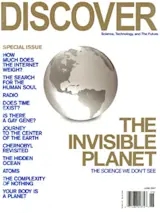How heavy is information? Most of us know that computers represent all types of information—e-mails, documents, video clips, Web pages, everything—as streams of binary digits, 1s and 0s. These digits are mathematical entities, but they are also tangible ones: They are embodied and manipulated as voltages in electronic circuits. Therefore, every bit of data must have some mass, albeit minuscule. This prompted DISCOVER to ask the question: How much would all the data sent through the Internet on an average day weigh?
In searching for an answer, we scanned technical databases, tore through reference books, Googled like crazy, and checked with experts. It soon became apparent that if we wanted an answer, we were going to have to work it out for ourselves, as no one else appears to have tackled this question before*. So we put our thinking caps on and set the coffee machine on extra strong.
The ...















